Silkworm (missile)
The Shang You or SY-series (Chinese: 上游; pinyin: shàngyóu; lit.: 'Upstream'), and the Hai Ying or HY-series (Chinese: 海鹰; pinyin: hǎiyīng; lit.: 'Sea Eagle') were early Chinese anti-ship cruise missiles. They were derived from the Soviet P-15 Termit missile.
| Silkworm | |
|---|---|
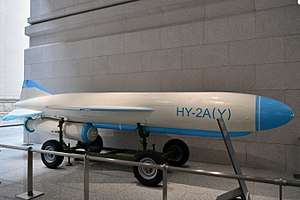 HY-2A missile. | |
| Type | Anti-ship cruise missiles |
| Place of origin | China |
| Specifications | |
| References | |
The HY-1 and HY-2 received the NATO reporting name Silkworm. However, to confuse matters, Western media also referred to the SY-series, and its export derivatives, the Fei Long or FL-series (Chinese: 飞龙; pinyin: fēilónɡ; lit.: 'Flying Dragon'), as Silkworms.
While it is not a particularly sophisticated missile when compared to newer generations of anti-ship missiles such as the French Exocet or Russian Kh-15 and P-800 Oniks, the Silkworm's unusually large warhead ensures that a single hit will inflict very serious damage.
SY-series
The SY-series were developed from the Soviet P-15 Termit. They were used on small missile boats with limited electronics. The Chinese encountered difficulties making the missile compatible with the more complex systems of larger warships. This could have resulted in premature launches or detonations when the electronics were placed on full power. In response, the HY-series was designed for warships and to replace the SY-series.
The SY-series was initially produced concurrently with the HY-series to arm missile boats and to provide an inexpensive alternative for export.
SY-1
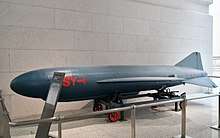
This is the original Chinese version of Soviet P-15 Termit missile, and the first was SY-1, produced at Factory 320 (the Nanchang Aircraft Factory, 南昌飞机制造厂); Chinese sources identify the designers as Li Tongli and Lu Lin. The main difference between P-15 Termit and SY-1 missiles is that the unreliable aneroid altimeter of P-15 Termit was replaced by a much more reliable radar altimeter in SY-1. The successor of SY-1, designed by Peng Lisheng (彭历生) and designated as SY-1A, had a mono-pulse terminal guidance radar seeker replacing the original conical scanning radar seeker. The missile received a NATO reporting name CSS-N-1 Scrubbrush.
The missile has been upgraded to be air-launched, and the air-launched version is known as C-601 (YJ-6), which is the first air-launched anti-ship missile in China. The missile received a NATO reporting name CAS-1 Kraken. It was used by Iraqi H-6Ds during Iran–Iraq War. An upgraded version that is fully solid state (electronics) with integrated circuitry and new active radar homing seeker and new radar altimeter entered service as SY-1A in early 1980s.
Specifications:
- Length: 6.55 metre
- Diameter: 0.76 metre
- Wingspan: 2.4 metre
- Weight: 2,095 kg
- Warhead: 513 kg shaped charge high explosive
- Propulsion: One liquid rocket engine and one solid rocket booster
- Speed: Mach 0.8
- Range: 150 km[1]
- Cruising altitude: < 20 metres
- Guidance: Inertial guidance + active conical scanning terminal guidance radar (SY-1); or inertial + active monopulse radar (SY-1A)
- Single-shot kill probability: 70%
SY-2
The liquid fuel engine was a rather hazardous and unreliable, so a solid fuel rocket engine was developed. This engine also made it possible to reduce the size and weight of the missile while providing greater range. The warhead weight is also reduced, but its effectiveness was actually increased when a time-delayed semi-armour-piercing high-explosive design was adopted. The extended version developed is designated SY-2A.
Specification:
- Length: 6 metre
- Diameter: 0.54 metre
- Wingspan: 1.7 metre
- Weight: 1,720 kg
- Warhead: 365 kg shape charged high-explosive
- Propulsion: A solid rocket engine and a solid booster
- Speed: Mach 0.9
- Range: 130 km[2]
- Cruising altitude: 20 metre
- Guidance: Inertial + active radar
- Single-shot kill probability: 70%
HY-series
HY-1
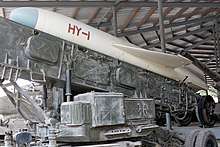
The HY-1 received two separate NATO reporting name, the CSS-N-2 Safflower for the ship to ship version and the CSSC-2 Silkworm for the land based coastal defense variant.
The HY-1J was intended for use on the Type 051 destroyers. However, the turmoil of the Cultural Revolution prolonged development into the 1980s. As a result, the Type 051s deployed into the Pacific Ocean to support ballistic missile tests without anti-ship missiles.
Variants
- HY-1: Basic developmental version developed from the SY missiles, used only in very small numbers as land-to-ship missile for evaluation purposes. Did not enter series production and was replaced by HY-1J.
- HY-1J: Ship-to-ship variant for Type 051 DDG
- HY-1JA: Improved ship-to-ship variant with a new radar seeker for better anti-jamming capability and accuracy
- HY-1A: Land-to-ship variant based on the HY-1JA
- HY-1B: Low level target drone for the test of HQ-2A SAM
- HJ-1YB Target drone for the test of HQ-61 SAM
Specifications
- Length: 6.60 metre
- Diameter: 0.76 metre
- Wingspan: 2.4 metre
- Weight: 2,300 kg
- Warhead: 513 kg shaped charge high explosive
- Propulsion: One liquid rocket engine and one solid rocket booster
- Speed: Mach 0.8
- Range: 85 km
- Cruising altitude: 100~300m (early models); <20m (later models)
- Guidance: Inertial + active conical scanning terminal guidance radar (early models); or inertial + monopulse active radar (later models)
- Single-shot kill probability: 70%
HY-2
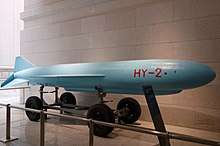
_Missile_20170902.jpg)
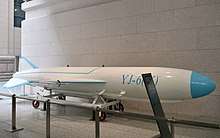
The HY-2 is identical to the HY-1 but with a further stretched body. The missile features a round nose accommodating the radar seeker, a pair of mid-mounted delta wings on the middle section of missile body, and three tail control surfaces. The missile is powered by a liquid-fuel rocket motor, with a solid rocket booster attached under the missile fuselage.
The HY-2 is launched from land-based launcher and flies at an altitude of 1000 m during the initial stage of the flight. After the missile switched to the cruising mode, the flight altitude was reduced to 100 ~ 300 m. During the final stage of the flight, the missile switched on its radar seeker and dives to an altitude of 8 m until it hits the target. The single-shot hit probability is estimated to be 90%. Due to its oversized body, the HY-2 did not develop a ship-to-ship variant. The missile is obsolete and will be replaced by the YJ-8 series in the future.[3]
The HY-2 was widely exported to the Middle East, and was the missile most associated with the silkworm nickname.
Variants
- HY-2: Basic variant radar-guidance land-to-ship missile *developed from the HY-1 missile
- HY-2A: IR-guidance variant
- HY-2AII: Improved variant of the HY-2A
- HY-2B: Improved radar-guidance variant with a monopulse radar seeker replacing the original conical scanning radar
- HY-2BII: Improved variant of the HY-2B with a newly designed radar seeker
- C-201: Export designation for HY-2.
- C-201W Extended-range variant powered by a turbojet engine replacing the original liquid-fuel rocket motor. Export only
- YJ-6: Air launched variant of the HY-2
- YJ-61: Improved variant of the YJ-6
Specifications
- Dimensions: Length: 7.48 m; Diameter: 0.76 m; Wingspan: 2.4 m
- Launch weight: 2,998 kg
- Warhead: 513 kg shaped charge high-explosive
- Propulsion: One liquid rocket engine and one solid rocket booster
- Speed: Mach 0.8
- Range: 200 km
- Flight altitude: < 20m
- Guidance: Inertial + active conical scanning terminal guidance radar (HY-2); or inertial + infrared homing guidance (HY-2A); or inertial + monopulse active radar (HY-2B)
- Single-shot hit probability: 90%
HY-3
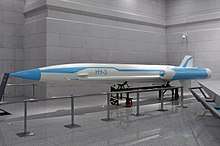
The HaiYing-3 (HY-3, also known as C-301 in its export name; NATO codename: CSS-C-6 Sawhorse) is the active radar homing, ramjet-powered supersonic land-to-ship missile developed by China Haiying Electro-Mechanical Technology Academy (CHETA, also known as 3rd Space Academy). The missile was developed in the 1980s based on the design of the HY-2 (C-201) and the ramjet technology of the cancelled YJ-1 (C-101). The development was completed in the early 1990s but the missile did not enter service.
The HY-3 is a large-size missile with a slim forward body and sharp nose, and a fatter rear half with four solid rocket boosters and two ramjet engines located aft of the missile body. There are a pair of front-canards on the front fuselage, four control surfaces on the rear fuselage, and four smaller stabilising fins attached on the solid rocket boosters. The booster motors accelerate the missile to past Mach 1.8 and the kerosene-fuelled ramjet engines accelerate the missile to a cruise speed of Mach 2.0. Its range is variously reported as up to 130 km, and it can fly as low as 50 m in its terminal attack phase. The missile is programmed to dive from cruising altitude to under 30m before the active-radar terminal phase begins, then dive onto the target just prior to impact.
The 3.5t missile is launched from a land-based launcher. Each firing unit consists of four launchers, a target acquisition radar, a fire-control unit, a power unit, and 8~12 missile reloading vehicle (each with one missile).[4]
Specifications
- Length: 9.85m
- Diameter: 0.76 m
- Wingspan: 2.24 m
- Weight: 3,400 kg
- Warhead: 300~500 kg time-delayed semi-armour-piercing high-explosive
- Propulsion: Two side-mounted ramjet engines; four solid propellant boost motors
- Speed: Mach 2.5
- Range: 180 km
- Flight altitude: 50 m
- Guidance: Inertial and terminal active radar
HY-4
The HY-4 development of the C-201 is a mid-range ground-, air-, and ship-launched cruise missile. Development of the C-201 HY-4 is believed to have started in the mid-1970s, replacing the C-201 HY-2 liquid propellant sustainer motor with a small turbojet engine, and adding a monopulse active radar seeker. Apart from the substitution of the turbojet engine, the overall configuration of the HY-4 variant of the C-201 missile is similar to the HY-2 variants of the C-201, with two delta wings and tri-form rudder and tail. The missile has a radar altimeter which allows the cruise height to be varied between 70 and 200 m altitude, followed by a steep dive onto the target. The air-launched version is designated as C-401
Specifications
FL-series
The FL-series was designed as land-based counterparts to the SY-series, and had a much longer production run than the SY-series. The FL-series was less expensive since it did not have to deal with more demanding conditions at sea. An added benefit was the ability to locate the missiles separately from the targeting and control systems, which improved survivability and flexibility. The SY-, HY-, and FL-series all shared the same systems.
A supersonic version, the FL-7, was also developed but differed significantly from the SY-series and its immediate derivatives.
FL-1
The FL-1 (NATO designation CSS-NX-1) was a SY-1 with a high-frequency monopulse seeker. It used a radar altimeter to cruise at 30 metres.[8]
FL-2
The FL-2 anti-ship missiles was the land-based derivative of the SY-2. It was produced at the Nanchang Aircraft Factory (南昌飞机制造厂).
SFQ-1
SFQ-1 was an unarmed test vehicle derivative of the Silkworm missile family. The test vehicle was used in the Chinese development of small turbojets that were designed to improve the range of the Chinese anti-ship cruise missiles, as well as powering the experimental versions of land attack YJ-4 cruise missiles. The entire project was reportedly named as Kunpeng (鲲鹏) Project, which first started in the early 1970s. SFQ-1 was specifically developed to test mini turbojet engines WP-11 and FW-41, the Chinese reverse engineered western turbojet engines for UAVs and missiles.
YJ-4
YJ-4 is a family of experimental land-attack cruise missiles developed by China in the 1970s and early 1980s. Due to the limitation of Chinese industrial and technological bottleneck at the time, the YJ-4 only entered the Chinese services in extremely limited numbers, mainly serving as a foundation for more successful Chinese cruise missiles developed later, such as Changfeng missile. Two versions of YJ-4 family were developed: YJ-4I, which is also frequently but erroneously referred as YJ-41, and YJ-4II, which is also frequently but erroneously referred as YJ-42. The two missiles only differed in their respective powerplant, YJ-4I was equipped with WP-11, the Chinese version of Turbomeca Marboré, while the longer ranged YJ-4II was equipped with an engine that was twice as powerful, FW-41, the Chinese version of Teledyne CAE J69, reversed engineered from downed American Ryan Firebee.
XW-41
A developed version based on HY-4, known as the XW-41, has been developed. This latest version of the C-201 missile family is said to have a 300 km range with additional GPS/GLONASS guidance. However, due to the availability of more advanced anti-ship missile with similar range, such as the C-602, the future of XW-41, like others in the Silkworm missile family, is uncertain despite its successful trials. Although still a member of Silkworm missile, the developer considers the missile was different enough to be a listed as a separate category of its own due to the amount of new technologies adopted. After the Gulf War, United Arab Emirates ordered 30 of these shore-based version for coastal defense, and accordingly to Jane's Defence Weekly, these missiles are referred by the general name Silkworm missiles, but domestic Chinese sources have claimed that these were XW-41s, though there are reports claiming these missiles are other models of Silkworm series.
C-611
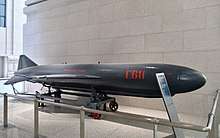
Upgraded version of C-601 and other earlier models of the air-to-surface missiles of Silkworm family. Not all upgrades are necessarily the same due to difference between various versions, but electronics for all versions are upgraded to the latest standard. The seeker of the missile is modernized to include semi-active radar homing and passive homing capability, and the missile can be used against coastal ground targets. Cruise altitude is decreased while the range is increased.
YJ-63 (C-603)
XW-41 and its predecessor HY-4 lost their intended market when the wars in middle east ended, so XW-41 was converted to the first indigenously developed air-to-surface precision strike missile. The developmental work begun in the mid-1990s when Sea Eagle Mechanical-Electrical Research Academy (海鹰机电技术研究院) received support of Chinese military and the project was completed in 2002. The resulting new missile was named as YJ-63, also known as C-603. In comparison to XW-41, the original radar guidance was changed to TV guidance. The original inverted Y-configuration of tail control surfaces was changed to X-configuration. Like its predecessor, XW-41, turbojet engine was adopted instead of liquid fuel rocket engine used on HY-2. Range is 500km.[9]
KD-63
Newest version of YJ-63 series that entered service in 2004 - 2005. This land attack version is almost identical to C-603 in appearance, except it has a solid nose instead of a window for TV guidance optronics. The solid nose indicates that the guidance of this air-to-surface missile adopts other means of guidance such as radar, but the exact type remain unknown.
KN-1
North Korean KN-1 or KN-01 versions of Silkworm Chinese and Russian P-15 Termit, Rubezh, P22 P20, and KN-01 are called Geum Seong-1 (Korean: 금성-1호) and produced locally.
Nomenclature
| Chinese industrial designation | Export type designation | NATO reporting name | NATO/U.S DOD code | Remarks |
|---|---|---|---|---|
| Shang You (SY-1) | FL-1 | SCRUBBRUSH | CSS-N-1 | tbd |
| Shang You (SY-2) | FL-2 | SABBOT | CSS-N-5 | tbd |
| Hai Ying (HY-1) | tbd | SAFFLOWER | CSS-N-2 | ship-launched |
| Hai Ying (HY-1) | tbd | SILKWORM | CSSC-2/CSS-N-2 | land-launched |
| Hai Ying (HY-2) | C-201 | SEERSUCKER | CSSC-3 | land-launched |
| Hai Ying (HY-3) | C-301 | SAWHOUSE | CSSC-6 | land-launched |
| Hai Ying (HY-4) | C-401 | SADSACK | CSSC-7 | land/air-launched |
| Ying Ji (YJ-4I) | not applicable | none | none | land/air-launched |
| Ying Ji (YJ-4II) | not applicable | none | none | land/air-launched |
Operational history
The Silkworm was developed at the Institute of Mechanics under Qian Xuesen, a Chinese scientist who did his graduate studies at MIT and Caltech, before being deported by the United States in 1955 after being suspected of Communist ties. A book about this scientist's life was written by Iris Chang, entitled Thread of the Silkworm.
Iran–Iraq War
The Silkworm gained fame in the 1980s when it was used by both sides in the Iran–Iraq War; both countries were supplied by China. During 1987, Iran launched a number of Silkworm missiles from the Faw Peninsula, striking the American-owned, Liberian-flagged tanker Sungari and U.S.-flagged tanker Sea Isle City in October 1987.[10] Five other missiles struck areas in Kuwait earlier in the year. In October 1987, Kuwait's Sea Island offshore oil terminal was hit by an Iranian Silkworm which was observed to have originated from the Faw peninsula. The attack prompted Kuwait to deploy a Hawk missile battery on Failaka Island to protect the terminal.[11] In December 1987, another Iranian Silkworm was fired at the terminal, but it struck a decoy barge instead.[12] Prior to these attacks the missile's range was thought to be less than 80 kilometres (50 mi), but these attacks proved that the range exceeded 100 kilometres (62 mi) with Kuwaiti military observers seeing that the missiles originated from the area and tracking them on radar along with US satellite imagery of the launch sites.[13]
Iraqi forces combined SS-N-2 (P-15 Termit) launched from Tu-22, Exocet missiles launched from Mirage F1 and Super Etendard, as well as Silkworm missiles and C-601 missiles launched from Tu-16 and H-6 bombers, bought from the Soviet Union and China to engage the Iranian Navy and tankers carrying Iranian oil.
In March 1988, China agreed to stop supplying Iran with HY-2 missiles, though it reportedly supplied Iran until 1989. Iran has since developed the capability to manufacture these missiles itself.
Persian Gulf War
On February 25, 1991 a shore-based Iraqi launcher fired two Silkworm missiles at the USS Missouri which was in company with the USS Jarrett and HMS Gloucester. A Sea Dart missile from HMS Gloucester shot down one Silkworm and the other missed, crashing into the ocean.[14] Royal Air Force officers subsequently recovered an HY-2 missile at Umm Qasr in southern Iraq. It is currently displayed at the RAF Museum Cosford.[15]
Iraq War
During the Iraq War, Iraq used the Silkworm as a surface to surface missile by firing at least two of them at the coalition positions in Kuwait.[16]
2006 Lebanon War
During the 2006 Lebanon War, it was initially reported that Hezbollah guerillas fired a Silkworm missile at an Israeli warship off the shore of Lebanon. Israeli sources later said that the missile used instead was a more sophisticated Chinese C-701.
Operators
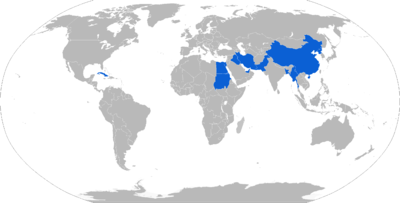
Current operators










References
- "Archived copy". Archived from the original on 2008-10-11. Retrieved 2013-10-15.CS1 maint: archived copy as title (link)
- "Archived copy". Archived from the original on 2007-08-20. Retrieved 2013-10-15.CS1 maint: archived copy as title (link)
- "Navy HY-6". SinoDefence. Archived from the original on 19 October 2008. Retrieved 8 October 2015.
- "Navy HY-6". SinoDefence. Archived from the original on 25 April 2013. Retrieved 8 October 2015.
- "Commission to Assess the Ballistic Missile Threat to the United States". Federation of American Scientists. Retrieved 2009-04-19.
- "HY-4". MissileThreat.com. Retrieved 2009-04-19.
- "Navy HY-6". SinoDefence. Retrieved 8 October 2015.
- Friedman, Norman (2006). The Naval Institute Guide to World Naval Weapon Systems (5th ed.). Naval Institute Press. p. 514. ISBN 1-55750-262-5.
- https://www.armscontrol.org/print/3983
- "U.S. Flag Tanker Struck by Missile in Kuwaiti Waters; First Direct Raid". The New York Times. October 17, 1987.
- "The Gulf Punch, Counterpunch". Time.
- "Iranian Silkworm strikes decoy barge"; Daniel J. Silva. St. Petersburg Times. St. Petersburg, Fla.: December 8, 1987. p. 14.A.
- Counter-memorial and Counter-claim submitted by the United States of America Archived 2014-03-31 at the Wayback Machine. June 23, 1997.
- Rostker, Bernard (December 2000). "TAB H – Friendly-fire Incidents". Depleted Uranium in the Gulf (II). United States Department of Defense. Retrieved 2007-02-25.
- "Hai Ying 2G Seersucker". RAF Museum. Retrieved 17 May 2014.
- Friendly printed version: Iraq’s missile and rocket activity during spring 2003, according to the 32d Army Air and Missile Defense Command Archived 2003-12-23 at the Wayback Machine
- "Trade-Register-1971-2018.rft". Stockholm International Peace Research Institute. Retrieved 2019-04-21.
External links
| Wikimedia Commons has media related to |